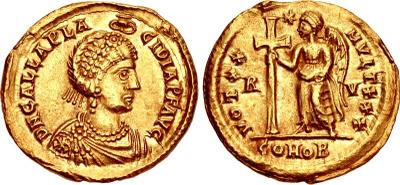VOT XX MVLT XXX
Bust of Galla Placidia to the right, draped with Chi-Rho (2) on right shoulder, wearing a diadem of pearls, a double necklace of pearls and long earrings. Above, the hand of God crowning her.
An angel standing left and holding a long Latin cross adorned with jewels. A star above the angel.
Marks
Photo of a coin sold the 12/09/2007 by Classical Numismatic Group, Mail Bid Sale 76, link to the sale: https://www.acsearch.info/search.html?id=393477, link to their website: https://www.cngcoins.com/.
The RIC X noted the same type of coin for two numbers: 2012 and 2020, however the illustrations show a Latin cross for the RIC 2012 and a Chi - Rho (1) or (2) indeterminate because the photo does not clearly show if a loop is present. Had the RIC noticed this change of cross? It seems that he classified these two numbers only according to their period of circulation. The RIC also noted that the n° 2020 and 2021 illustrated plate 49, share the same reverse die. The Classical Numismatic Group coin shown here has a different reverse die.
I noticed a detail in this mint on Solidi type SALVS REIPVBLICAE and VOT XX MVLT XXX. The Chi-Rho on the right shoulder is either: I X with a loop surmounting the letter, I noted Chi-Rho (1) as we see on the AYC #9, RIC 2012. Or: I X noted Chi-Rho (2). We can consider that this small loop may have been forgotten. But we can also imagine that the engraver wanted to mark his faith in this way. Indeed I X is the first Chi-Rho symbolizing ''Iêsous Christos''. And the addition of the loop or letter P is the Constantine form. The Chi-Rho (2) on this type is confirmed, even if one seems to distinguish a beginning of loop which could be erased on this coin illustrated here. I found other coins using the same obverse die where the cross does not seem to have a loop but simply an awkward engraving on the vertical bar at the top right. Other different dies do not show a complete loop either, only the same peculiarity as on this coin: a thicker vertical bar, seem to slightly join the horizontal bar. This Chi-Rho (2) is confirmed and very clear on the AYC # 8 var.
The cross may seem undecorated on the reverse on some coins, I take this one as an example:

Photo of a coin sold the 18/05/2016 by Classical Numismatic Group, Auction 102, lot 1123, link to the sale: https://www.acsearch.info/search.html?id=3092270, link to their website: https://www.cngcoins.com/.
I did not classify this coin as a variant because the wear may have erased the jewels, however we must keep this coin aside and see if one day a much less worn copy confirms the absence of jewels. See also AYC # 2 obv. link which shares the same particularity.
All Solidi of all types and in all mints (except the one in Constantinople) always display a double pearl necklace. Except for AYC # 7 (see comment). This little detail may make the difference with the smaller denominations.
A ribbon emerges from the two letters G on the obverse. Common thing with the mints of this region for this period. It seems that all Solidi of all types have at least one prominent ribbon.
On the reverse I noted ''Angel'' in the description. We can also say that this is Victoria but the image of the victory at that time had indeed become that of an angel symbolizing the Christian victory. I note that this character is probably also a representation of the Empress in the guise of the angel. Indeed, the character often wears the same double pearl diadem and the clothes are decorated like those of Galla Placidia. I have noticed many times that on the coinage of various Empresses the character on the reverse is depicted as the Empress.

